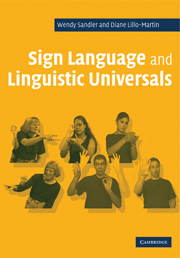Book contents
- Frontmatter
- Contents
- Preface
- Notation conventions
- UNIT I INTRODUCTION
- UNIT II MORPHOLOGY
- UNIT III PHONOLOGY
- UNIT IV SYNTAX
- 17 Syntax: introduction
- 18 Clausal structure
- 19 Clausal structure across sign languages
- 20 Variations and extensions on basic sentence structures
- 21 Pronouns
- 22 Topic and focus
- 23 WH-questions
- 24 Syntax: summary and directions
- UNIT V MODALITY
- References
- Index
18 - Clausal structure
Published online by Cambridge University Press: 05 June 2012
- Frontmatter
- Contents
- Preface
- Notation conventions
- UNIT I INTRODUCTION
- UNIT II MORPHOLOGY
- UNIT III PHONOLOGY
- UNIT IV SYNTAX
- 17 Syntax: introduction
- 18 Clausal structure
- 19 Clausal structure across sign languages
- 20 Variations and extensions on basic sentence structures
- 21 Pronouns
- 22 Topic and focus
- 23 WH-questions
- 24 Syntax: summary and directions
- UNIT V MODALITY
- References
- Index
Summary
Syntax begins with phrase structure. However, in over twenty-five years of research on the syntactic structure of ASL, there are still controversies about its phrase structure. Initially, these stemmed from debate over the basic word order. Word order is flexible in ASL and other sign languages, and therefore the basic structure of the clause is not immediately obvious. Around 1980, a consensus seemed to have been reached that the basic order of elements in ASL is Subject–Verb–Object (SVO). This is the order which is used in pragmatically neutral contexts, such as the answer to a general question like, What happened?
However, as recently as the mid-1990s (Bouchard and Dubuisson 1995, Bouchard 1996), the proposal that sign languages (in this case, ASL and Quebec Sign Language – Langue des Signes Québecoise, LSQ) have no set basic word order has been resurrected. We will review some of the history of this debate, as it provides data which in many cases still today require adequate analysis. It also encompasses two fundamental controversies in the pursuit of universals: whether sign languages are structured differently from spoken languages, and whether all languages (spoken or signed) require hierarchical structure.
Even with the adoption of S–V–O as the “basic” word order for a language such as ASL, the underlying clausal hierarchy is not automatically determined. In recent years, several variants of phrase structure for ASL have been proposed.
- Type
- Chapter
- Information
- Sign Language and Linguistic Universals , pp. 288 - 319Publisher: Cambridge University PressPrint publication year: 2006



